Cisalpine Gaul
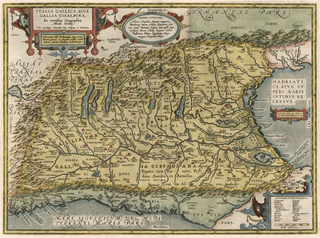
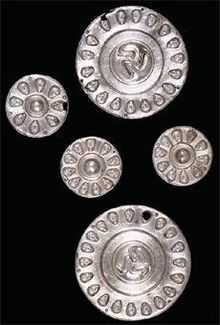
Cisalpine Gaul (Gallia Cisalpina), also called Gallia Citerior or Gallia Togata,[2] was the part of Northern Italy inhabited by Celts (Gauls) since the 4th century BC. Conquered by the Roman Republic in the 220s BC, it was a Roman province from c. 81 BC until 42 BC, when it was merged into Roman Italy.[3] Until that time, it was considered part of Gaul, precisely that part of Gaul on the "hither side of the Alps" (from the perspective of the Romans), as opposed to Transalpine Gaul ("on the far side of the Alps").[4]
Gallia Cisalpina was further subdivided into Gallia Cispadana and Gallia Transpadana, i.e. its portions south and north of the Po River, respectively. The Roman province of the 1st century BC was bounded on the north and west by the Alps, in the south as far as Placentia by the river Po, and then by the Apennines and the river Rubicon, and in the east by the Adriatic Sea.[5] In 49 BC all inhabitants of Cisalpine Gaul received Roman citizenship,[6] and eventually the province was divided among four of the eleven regions of Italy: Regio VIII Gallia Cispadana, Regio IX Liguria, Regio X Venetia et Histria and Regio XI Gallia Transpadana.[7]
History
Early history

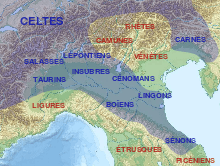
There are no historical sources on Gauls south of the Alps prior to the 4th century BC. But it seems likely that the early Celts, who were the bearers of the Hallstatt culture north of the Alps, were in cultural contact with the bearers of the Golasecca culture from an early time, and Celtic peoples may have settled south of the Alps from as early as the 6th century BC in what is now the Swiss canton of Ticino, specifically the Lepontii, who during that time left inscriptions in the area of Lake Lugano and Lago Maggiore.
The late Golasecca culture shows increasingly strong Celtic cultural influence, but at the same time there was an expansion of the Etruscan civilization from the south, the Po Valley being culturally dominated by the Etruscans by the end of the 6th century BC. Northern Italy during the 5th century BC was thus an ethnic mix of Gauls, Etruscans, Ligurians, Raetians and Venetians, and only in the 4th century BC did the Gauls gain the upper hand, to be replaced in turn by the Romans by the end of the 3rd century BC.
Polybius in the 2nd century BC wrote about co-existence of the Celts in northern Italy with Etruscan nations in the period before the Sack of Rome in 390 BC. Livy (v. 34) has the Insubres, led by Bellovesus, arrive in northern Italy during the reign of Tarquinius Priscus (6th century BC), occupying the area between Milan and Cremona. Milan (Mediolanum) itself is presumably a Gaulish foundation of the early 4th century BC, its name having a Celtic etymology of "[city] in the middle of the [Padanic] plain".
Gallic expansion and Roman conquest
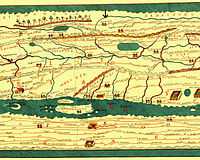
In 391 BC, Celts "who had their homes beyond the Alps, streamed through the passes in great strength and seized the territory that lay between the Appennine mountains and the Alps" according to Diodorus Siculus. The Roman army was routed in the battle of Allia, and Rome was sacked in 390 BC by the Senones.
The defeat of the combined Samnite, Celtic and Etruscan alliance by the Romans in the Third Samnite War ending in 290 BC sounded the beginning of the end of the Celtic domination in mainland Europe. At the Battle of Telamon in 225 BC, a large Celtic army was trapped between two Roman forces and crushed.
In the Second Punic War, the Boii and Insubres allied themselves with the Carthaginians, laying siege to Mutina (Modena). In response, Rome sent an expedition led by L. Manlius Vulso. Vulso's army was ambushed twice, and the Senate sent Scipio with an additional force of in support. These are the Roman forces encountered by Hannibal after his crossing of the Alps. The Romans were defeated in the Battle of the Ticinus, moving all Gauls except for the Cenomani to join the insurgency. Rome now sent the army of Tiberius Sempronius Longus who engaged Hannibal in the Battle of the Trebia, also resulting in a Roman defeat, forcing Rome to temporarily abandon Gallia Cisalpina altogether, returning only after the defeat of Carthage in 202 BC. Rome conquered the last remaining independent Celtic kingdom in Italy in 192 BC.
Roman province
Sometimes referred to as Gallia Citerior ("Hither Gaul"), Provincia Ariminum, or Gallia Togata ("Toga-wearing Gaul", indicating the region's early Romanization). Gallia Transpadana denoted that part of Cisalpine Gaul between the Padus (now the Po River) and the Alps, while Gallia Cispadana was the part to the south of the river.
Probably officially established around 81 BC, the province was governed from Mutina (modern-day Modena), where, in 73 BC, forces under Spartacus defeated the legion of Gaius Cassius Longinus, the provincial governor.
In 49 BC, with the Lex Roscia, Julius Caesar granted to the populations of the province the full Roman citizenship.
The Rubicon River marked its southern boundary with Italia proper. By crossing this river in 49 BC with his battle-hardened legions, returning from the conquest of Gaul, Julius Caesar precipitated the civil war within the Roman Republic which led, eventually, to the establishment of the Roman Empire. To this day the term "crossing the Rubicon" means, figuratively, "reaching the point of no return".
The province was merged into Italia about 42 BC, as part of Octavian's "Italicization" program during the Second Triumvirate. The dissolution of the provincia required a new governing law or lex, although its contemporary title is unknown. The parts of it inscribed on a bronze tablet preserved in the museum at Parma are entirely concerned with arranging the judiciary: the law appoints two viri and four viri juri dicundo, and also mentions a Prefect of Mutina.
Virgil, Catullus and Livy,[8] three famous sons of the province, were born in Gallia Cisalpina.[9]
Archaeology
The Canegrate culture
The Canegrate culture reflects a late Bronze Age to early Iron Age culture in the Pianura Padana. These areas are now known as western Lombardy, eastern Piedmont and Canton Ticino.
The Canegrate culture testifies to the arrival of a first "proto-Celtic"[10] migratory wave of populations from the northwest part of the Alps that, crossing the alpine passes, had not yet infiltrated and settled down in the western Po area between Lake Maggiore and the Lake of Como. They were bearers of a new funerary practice, which supplanted the old culture of inhumation instead introducing cremation.
The population of Canegrate maintained its own homogeneity for a limited period of time, approximately a century, after which they blended with the Ligurian aboriginal populations to create a new culture called the Golasecca culture.
Golasecca culture
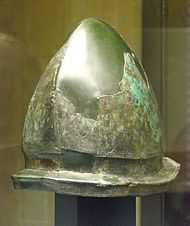
The Culture of Golasecca (9th to 4th centuries BC) spread between the end of the Bronze Age and the beginning of the Iron Age in the areas of northwestern Lombardy and Piedmont, and the Canton Ticino . At the end of the prehistoric period, this was an area where travelers frequently stopped and had contact with the Hallstatt culture to the west, the Urnfield culture to the north and with the Villanova culture to the south. The Golasecca culture was initially concentrated in the foothills area south of the Alps. It later spread throughout the lakes area, and established many settlements representing this original culture. The oldest remains found thus far can be dated from the 9th century BC.
Language
There is some debate whether the Lepontic language should be considered as a Gaulish dialect or an independent branch within Continental Celtic. Apart from Lepontic, the "Cisalpine Gaulish language" proper would be the Gaulish language as spoken by the Gauls invading northern Italy in the 4th century BC. This is a dialect of the larger Gaulish language, with some known phonetic features distinguishing it from Transalpine dialects, such as -nn- replacing -nd- and s(s) replacing -χs-.
Sources
- ↑ "Museo del monastero di Santa Giulia in Brescia". Santagiulia.info. Retrieved 2011-09-16.
- ↑ von Hefner, Joseph (1837). Geographie des Transalpinischen Galliens. Munich.
- ↑ Long, George (1866). Decline of the Roman republic: Volume 2. London.
- ↑ Snith, William George (1854). Dictionary of Greek and Roman geography: Vol.1. Boston.
- ↑ Schmitz, Leonhard (1857). A manual of ancient geography. Philadelphia.
- ↑ Cassius Dio XLI, 36.
- ↑ Brouwer, Hendrik H. J. (1989). Hiera Kala: Images of animal sacrifice in archaic and classical Greece. Utrecht.
- ↑ Uchicago.edu
- ↑ The Dawn of the Roman Empire, by Livy, John Yardley, Waldemar Heckel.
- ↑ Kruta, Venceslas: La grande storia dei celti. La nascita, l'affermazione e la decadenza, Newton & Compton, 2003, ISBN 88-8289-851-2, ISBN 978-88-8289-851-9
See also
- Canegrate culture
- Golasecca culture
- Cisalpine Gaulish
- Etruscans
- Iron Age Italy
- Ancient peoples of Italy
- Transalpine Gaul
Literature
- ARSLAN E. A. 1992 (1995), La Nécropole celtique de Garlasco (Province de Pavie), in L’Europe celtique du Ve au IIIe Siècle avant J.-C. (Hautvillers, 8-10 octobre 1992), Sceaux, pp. 169–188.
- Luigi Bossi, Della istoria d'Italia antica e moderna, Milano, 1819
- Jean Bousquet, La Cisalpine gauloise du IIIe au Ier siècle avant J.-C.
- Corbella, Roberto: "Celti : itinerari storici e turistici tra Lombardia, Piemonte, Svizzera", Macchione, Varese c2000; 119 p., ill.; 20 cm; ISBN 88-8340-030-5; EAN: 9788883400308
- Corbella, Roberto: "Magia e mistero nella terra dei Celti : Como, Varesotto, Ossola"; Macchione, Varese 2004; 159 p. : ill. ; 25 cm; ISBN 88-8340-186-7; EAN: 9788883401862
- D'Aversa, Arnaldo: "La Valle Padana tra Etruschi, Celti e Romani", PAIDEIA, Brescia 1986, 101 p. ill., 21 cm, ISBN 88-394-0381-7
- Raffaele De Marinis and Venceslas Kruta in ‘’Italia, omnium terrarum alumna’’, Garzanti-Scheiwiller, 1990
- Grassi, Maria Teresa: "I Celti in Italia" - 2. ed, Longanesi, Milano 1991 (Biblioteca di Archelogia); 154 p., 32 c. di tav., ill. ; 21 cm; ISBN 88-304-1012-8
- Grassi, Maria Teresa: "La ceramica a vernice nera di Calvatone-Bedriacum", All'Insegna del Giglio, Firenze 2008, pp. 224 brossura, ISSN/ISBN 9788878143692
- GRASSI M. T. 1995, La romanizzazione degli Insubri. Celti e Romani in Transpadana attraverso la documentazione storica e archeologica, Milano.
- GRASSI M. T. 1999, I Celti della Cisalpina Centrale: dall’ager Insubrium alla XI Regio Transpadana, in Insubri e Cenomani tra Sesia e Adige, Seminario di Studi (Milano 27-28.2.1998), “Rassegna di Studi del Civico Museo Archeologico e del Civico Gabinetto Numismatico di Milano”, LXIII-LXIV, pp. 101–108.
- Lawrence Keppie, The Making of the roman army, From Republic to Empire, University of Oklahoma, 1998
- Kruta, Venceslas: "I celti e il Mediterraneo", Jaca Book, 2004, 78 p., ISBN 88-16-43628-X, ISBN 978-88-16-43628-2
- Kruta, Venceslas: "La grande storia dei celti. La nascita, l'affermazione e la decadenza", Newton & Compton, 2003, 512 p., ISBN 88-8289-851-2, ISBN 978-88-8289-851-9
- Kruta, Venceslas & Manfredi, Valerio M.: "I celti d'Italia", Mondadori, 2000 (Collana: Oscar storia), ISBN 88-04-47710-5, ISBN 978-88-04-47710-5
- Giuseppe Micali, L'Italia avanti il dominio dei Romani, Genova, 1830
- Violante, Antonio; introduzione di Venceslas Kruta: "I Celti a sud delle Alpi", Silvana, Milano 1993 (Popoli dell'Italia Antica), 137 p., ill., fot.; 32 cm; ISBN 88-366-0442-0